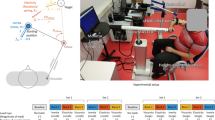Abstract
Current experimental methods for the study of reaching in the MRI environment do not exactly mimic actual reaching, due to constrains in movement which are imposed by the MRI machine itself. We tested a haptic robot (HR) as such a tool. Positive results would also be promising for combined use of fMRI and EEG to study reaching. Twenty right-handed subjects performed reaching tasks with their right hand with and without the HR. Reaction time, movement time (MT), accuracy, event-related potentials (ERPs) and event-related desynchronisation/synchronisation (ERD/ERS) were studied. Reaction times and accuracies did not differ significantly between the two tasks, while the MT was significantly longer in HR reaching (959 vs. 447 ms). We identified two positive and two negative ERP peaks across all leads in both tasks. The latencies of the P1 and N2 peaks were significantly longer in HR reaching, while there were no significant differences in the P3 and N4 latencies. ERD/ERS topographies were similar between tasks and similar to other reaching studies. Main difference was in ERS rebound which was observed only in actual reaching. Probable reason was significantly larger MT. We found that reaching with the HR engages similar neural structures as in actual reaching. Although there are some constrains, its use may be superior to other techniques used for reaching studies in the MRI environment, where freedom of movement is limited.







Similar content being viewed by others
References
Johnson PB, Ferraina S (1996) Cortical networks for visual reaching: intrinsic frontal lobe connectivity. Eur J Neurosci 8(7):1358–1362
Battaglia-Mayer A, Ferraina S, Genovesio A, Marconi B, Squatrito S, Molinari M, Lacquaniti F, Caminiti R (2001) Eye-hand coordination during reaching. II. An analysis of the relationships between visuomanual signals in parietal cortex and parieto-frontal association projections. Cereb Cortex 11(6):528–544. doi:10.1093/cercor/11.6.528
Crawford JD, Henriques DY, Medendorp WP (2011) Three-dimensional transformations for goal-directed action. Annu Rev Neurosci 34:309–331. doi:10.1146/annurev-neuro-061010-113749
Fogassi L, Luppino G (2005) Motor functions of the parietal lobe. Curr Opin Neurobiol 15(6):626–631. doi:10.1016/j.conb.2005.10.015
Rizzolatti G, Luppino G, Matelli M (1998) The organization of the cortical motor system: new concepts. Electroencephalogr Clin Neurophysiol 106(4):283–296
Berndt I, Franz VH, Bulthoff HH, Wascher E (2002) Effects of pointing direction and direction predictability on event-related lateralizations of the EEG. Hum Mov Sci 21(3):387–410
Gherri E, Van Velzen J, Eimer M (2007) Dissociating effector and movement direction selection during the preparation of manual reaching movements: evidence from lateralized ERP components. Clin Neurophysiol 118(9):2031–2049. doi:10.1016/j.clinph.2007.06.003
Naranjo JR, Brovelli A, Longo R, Budai R, Kristeva R, Battaglini PP (2007) EEG dynamics of the frontoparietal network during reaching preparation in humans. Neuroimage 34(4):1673–1682
Mirabella G, Pani P, Ferraina S (2011) Neural correlates of cognitive control of reaching movements in the dorsal premotor cortex of rhesus monkeys. J Neurophysiol 106(3):1454–1466. doi:10.1152/jn.00995.2010
Mattia M, Spadacenta S, Pavone L, Quarato P, Esposito V, Sparano A, Sebastiano F, Di Gennaro G, Morace R, Cantore G (2012) Stop-event-related potentials from intracranial electrodes reveal a key role of premotor and motor cortices in stopping ongoing movements. Front Neuroeng 5
Astafiev SV, Shulman GL, Stanley CM, Snyder AZ, Van Essen DC, Corbetta M (2003) Functional organization of human intraparietal and frontal cortex for attending, looking, and pointing. J Neurosci 23(11):4689–4699
Medendorp WP, Goltz HC, Crawford JD, Vilis T (2005) Integration of target and effector information in human posterior parietal cortex for the planning of action. J Neurophysiol 93(2):954–962. doi:10.1152/jn.00725.2004
Gallivan JP, Cavina-Pratesi C, Culham JC (2009) Is that within reach? fMRI reveals that the human superior parieto-occipital cortex encodes objects reachable by the hand. J Neurosci 29(14):4381–4391. doi:10.1523/JNEUROSCI.0377-09.2009
Grefkes C, Ritzl A, Zilles K, Fink GR (2004) Human medial intraparietal cortex subserves visuomotor coordinate transformation. Neuroimage 23(4):1494–1506. doi:10.1016/j.neuroimage.2004.08.031
Hayward V, Astley OR, Cruz-Hernandez M, Grant D, Robles-De-La-Torre G (2004) Haptic interfaces and devices. Sens Rev 24(1):16–29
Hribar A, Koritnik B, Munih M (2009) Phantom haptic device upgrade for use in fMRI. Med Biol Eng Compu 47(6):677–684
Chatrian GE, Lettich E, Nelson PL (1988) Modified nomenclature for the “10%” electrode system. J Clin Neurophysiol 5(2):183–186
Graimann B, Huggins JE, Levine SP, Pfurtscheller G (2002) Visualization of significant ERD/ERS patterns in multichannel EEG and ECoG data. Clini Neurophysiol 113(1):43–47
Neuper C, Wortz M, Pfurtscheller G (2006) ERD/ERS patterns reflecting sensorimotor activation and deactivation. Prog Brain Res 159:211–222. doi:10.1016/s0079-6123(06)59014-4
Alegre M, Gurtubay IG, Labarga A, Iriarte J, Malanda A, Artieda J (2003) Alpha and beta oscillatory changes during stimulus-induced movement paradigms: effect of stimulus predictability. Neuroreport 14(3):381–385. doi:10.1097/01.wnr.0000059624.96928.c0
Waldert S, Preissl H, Demandt E, Braun C, Birbaumer N, Aertsen A, Mehring C (2008) Hand movement direction decoded from MEG and EEG. J Neurosci 28(4):1000–1008
Toro C, Cox C, Friehs G, Ojakangas C, Maxwell R, Gates JR, Gumnit RJ, Ebner TJ (1994) 8–12 Hz rhythmic oscillations in human motor cortex during two-dimensional arm movements: evidence for representation of kinematic parameters. Electroencephalogr Clin Neurophysiol 93(5):390–403
Leocani L, Toro C, Zhuang P, Gerloff C, Hallett M (2001) Event-related desynchronization in reaction time paradigms: a comparison with event-related potentials and corticospinal excitability. Clin Neurophysiol 112(5):923–930
Stancak A Jr, Pfurtscheller G (1996) Mu-rhythm changes in brisk and slow self-paced finger movements. Neuroreport 7(6):1161–1164
Erbil N, Ungan P (2007) Changes in the alpha and beta amplitudes of the central EEG during the onset, continuation, and offset of long-duration repetitive hand movements. Brain Res 1169:44–56. doi:10.1016/j.brainres.2007.07.014
Raibert MH (1977) Motor control and learning by the state space model
Acknowledgments
Authors would like to thank Mr. Ignac Zidar for technical support and professor Gert Pfurtscheller for his advices regarding ERD/ERS analysis.
Author information
Authors and Affiliations
Corresponding author
Rights and permissions
About this article
Cite this article
Rakusa, M., Hribar, A., Koritnik, B. et al. Assessment of the haptic robot as a new tool for the study of the neural control of reaching. Neurol Sci 34, 1779–1790 (2013). https://doi.org/10.1007/s10072-013-1337-5
Received:
Accepted:
Published:
Issue Date:
DOI: https://doi.org/10.1007/s10072-013-1337-5




